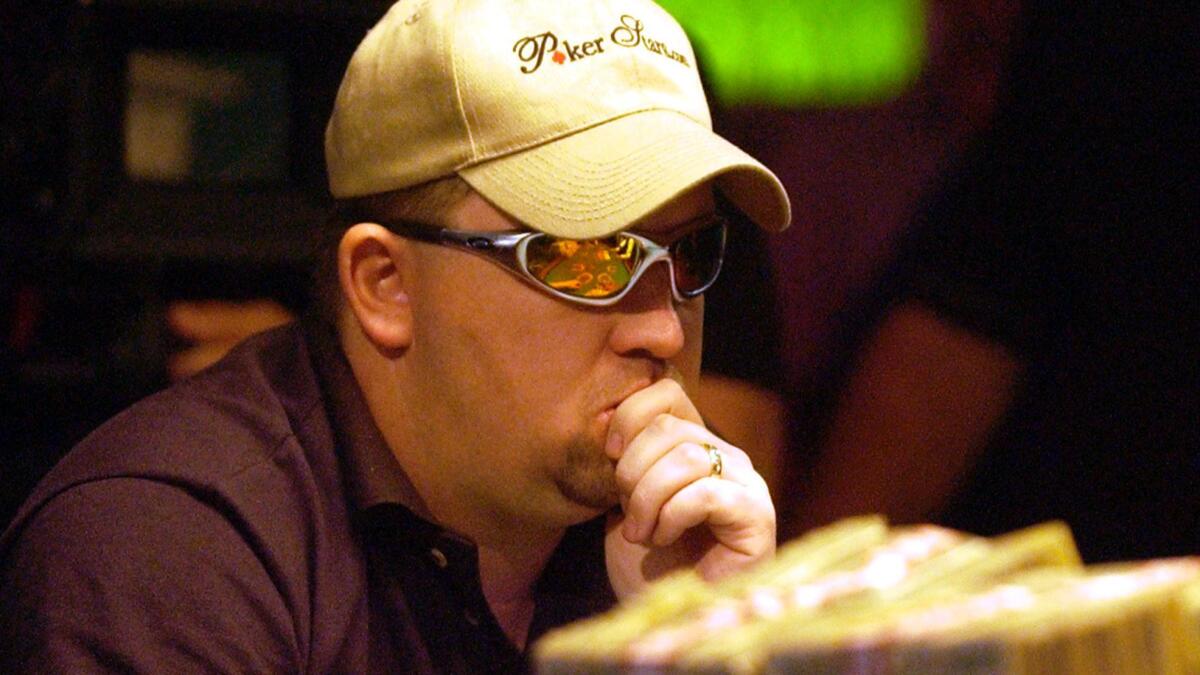Put your hands together for the World Series of Poker, turning 50 this year

- Share via
Reporting from Las Vegas — Poker players were once viewed as miscreants betting in backrooms filled with booze, guns and battlefield levels of cigar smoke hanging in the air.
Benny Binion, a charismatic casino owner who shot and killed two men in separate incidents — successfully arguing both times that it was self-defense — and was convicted for tax evasion, seemed cut from that cloth when he conceived the World Series of Poker in 1969. The tournament began in Reno as a small gathering of guys with nicknames such as Slim, Puggy, Sailor and Texas Dolly.
In 1970 , he relocated the game to Binion’s Horseshoe in downtown Las Vegas — moving other games to make room for the poker tables. The winner, Johnny Moss, was awarded a silver cup.
“Before long, [Binion] had a gathering of outlaws with long sideburns and polyester slacks playing stud,” wrote Doug Swanson in the book “Blood Aces: The Wild Ride of Benny Binion.”
Fifty years later, the World Series of Poker is run by corporate suits. There’s no smoking allowed at the poker tables. Few players drink liquor. Pros watch their diet, work out and drink bottled water. Guns? No more. Last year there were even serious discussions about having metal detectors put in place at the Rio Suites Hotel and Casino, where the World Series of Poker is now held.
The tournament begins again Tuesday — 89 events that will award a total of more than $266 million in prize money. The main event starts July 3 at noon. The tournament last year saw more than 123,000 descend upon Las Vegas over the course of 50 days, with participants from 102 countries. More than 89,000 came from the United States — 18,539 from California alone.
As the character Trent said in the Vegas-centric movie “Swingers”: “Our baby’s all grown up.”
Michael Green, associate professor of history at the University of Nevada Las Vegas, said that when the World Series of Poker was coming up through the 1970s, it was maturing with the city as the Las Vegas Strip began transitioning from mob rule to corporate governance.
Casino mogul and businessman Kirk Kerkorian was developing properties on the Las Vegas Strip. Steve Wynn would launch the Mirage as the first large mega-resort in the 1980s. And the Nevada Legislature passed an act that allowed corporations to begin obtaining gaming licensees whereas before only individuals could hold them.
Still, the old mix of renegades hadn’t vanished.
With Clark County’s population in 1970 at about 273,000, it was still a small town in the desert, and big mob names such as Tony Spilotro and Frank “Lefty” Rosenthal were high-profile enough that the city’s image to the rest of the country was a place of limited or no rules.
It wasn’t until 1978 that Spilotro was added to Nevada’s notorious “Black Book” barring him from setting foot in casinos.
Former U.S. Sen. Harry Reid, who was the Nevada Gaming Commission chairman at the time, recalled recently that he and his family received death threats over that decision. “That was a tough time,” he said.
Vegas remained a place where visitors came to do what they couldn’t do in Ohio — or most anywhere for that matter: gamble and drink 24/7. Prostitution may not have been legal in Clark County, but it was legal just an hour away. Showgirls, mobsters and members of the Rat Pack could be seen at the Sands, the Riviera or Caesars Palace. Sin City was the place to live rules-free for a weekend and maybe become instantly rich with the pull of a slot machine handle.
“There was certainly still this aura of where people were thinking, ‘This is a mob town and there could be a hit at the next table,’” Green said. “It was exciting and different.”
In 1970, there were seven entrants in the World Series of Poker. By 1980, it had grown to 73. In 1990, the year after Benny Binion died, the main event had swelled to 194 players. It kept growing.
In 2003, however, came the big poker explosion.
Chris Moneymaker was an accountant from Georgia who had won a seat at the main event by playing in an online tournament before the World Series of Poker. There were 839 people in the competition and he navigated his way through to the final table, finally defeating Sam Farha, a professional player, to claim $2.5 million. It was an unlikely and improbably story that fueled the imagination of casual players around the country.
The following year, 2,576 players entered the main event — many via online tournaments that could often be entered for less than $100. Otherwise, seats at the main event each cost $10,000.
Jack Effel, tournament director for the World Series of Poker, said the so-called Moneymaker Effect came at a time when poker was still considered a money loser for the casinos.
“I remember when I was working for the Horseshoe in the late ’90s and the early millennium and worked for a property where they closed the poker room,” Effel said. “They replaced it with penny slots. I wondered if the poker business was going to work out and I might have to change careers. I went back to school and got three degrees. Then 2003 happened.”
Over the next few years, the main event surged. By 2006, it had 8,773 participants. It had also had changed venues. In 2005, a year after Harrah’s Entertainment bought the Horseshoe and the World Series of Poker along with it, the tournament moved to the Rio. Harrah’s Entertainment became Caesars Entertainment in 2010.
It was also being televised on ESPN, which brought a broader audience to the game. According to an analysis by Cards Chat News, 615,000 people watched televised coverage of the final table in 2017 — more than O.J. Simpson’s parole hearing but below a five-game average of the NBA Summer League.
The game played is Texas Hold ’Em — which got its big boost in the 1998 movie “Rounders,” starring Matt Damon. In the game, players are dealt two cards face down — called hole cards — and betting starts from left to right.
Then three cards are flopped. They are community cards that can be combined with the two hole cards to form a hand. Betting ensues again. Another card is then turned face up. More betting.
Then the last card — known as “the river” — is turned face up from the deck. Players can use any five of the seven total cards to make a hand.
Norman Chad, a sportswriter who has been doing commentary for the World Series of Poker since 2003, said that when he was first asked to do it, he thought it would be a “one-and-done” gig. “I didn’t think anybody would watch it,” he said.
But people did and now he’s part of the world of poker and the event. He said he now likes to walk the room and meet the players — many of whom aren’t professionals and are simply there for the thrill of participating in a high-profile contest.
Some, he said, have parlayed poker success into new careers. Others, Chad said, he’s never seen again.
Chad said that to him, it remains the greatest sport or game because at any point, an amateur player can find himself playing a hand against the best in the world: Phil Hellmuth, Phil Ivey, Daniel Negranu. Celebrities and athletes have played in it as well, including Jose Canseco, Jason Alexander, Ben Affleck, Don Cheadle and Jennifer Tilly.
“You can’t just get up one day and play tennis against Roger Federer,” he said.
In recent years, the nine players who reach the final table have been guaranteed to each win at least $1 million. Last year, John Cynn won the main event out of a field of 7,784 players and cashed in for $8.8 million. The person who came in 1,182nd place — the last spot to finish in the money — earned $15,000.
“Anybody can play and anybody can win,” Chad said. “It’s the last American gold rush.”
More to Read
Sign up for Essential California
The most important California stories and recommendations in your inbox every morning.
You may occasionally receive promotional content from the Los Angeles Times.














